
Steel prices keep soaring regularly. Steel is difficult to obtain in developing countries due to high costs, and the use of steel is currently highly restricted in the construction industry. Steel manufacturing has a high use of fossil fuels, so steel disuse has been identified in the construction of buildings, demonstrating the likelihood of a drastic reduction by research institutes. In the meantime, in developing countries for advancement of construction; you need low costs alternative, by use of advanced technology and efficient construction methods. For a plenty of reasons reinforced concrete is mostly used for the construction in developing countries. Here we have done some initial research and gathered information on why we should restrict the use of steel and maximise the use of bamboo as reinforced concrete.
Issues with Steel

At present, the most commonly used building materials in the world are steel and concrete. The concrete has a high compressive strength but poor tensile strength. Therefore, to strengthen the concrete, steel is used. As opposed to concrete, steel has a very high tensile strength, but there are certain issues associated with it.
Some of them are, high energy usage during its production, and High production costs. They are a non-renewable resource and a significant amount of carbon emissions taken place during its production. The desire to solve these issues without compromising the tensile ability of reinforced concrete has prompted numerous scientists and engineers to look for locally sourced materials as a substitute for conventional steel reinforcement.
Bamboo: An Alternative to Steel
Specifically, bamboo is one of the most appropriate materials that can be used as a reinforcement bar in concrete. So here we are going to direct you to bamboo as reinforcement in concrete.
Bamboo grows in abundance all over the world. Bamboo structures continue to be used today in certain regions of the world. Bamboo is one of the fastest growing and renewable natural resource known to us. It is a small wonder, therefore, that this material was used extensively by our ancestors for construction. As a construction material, it has a long and well-established history in the tropical and sub-tropical regions.
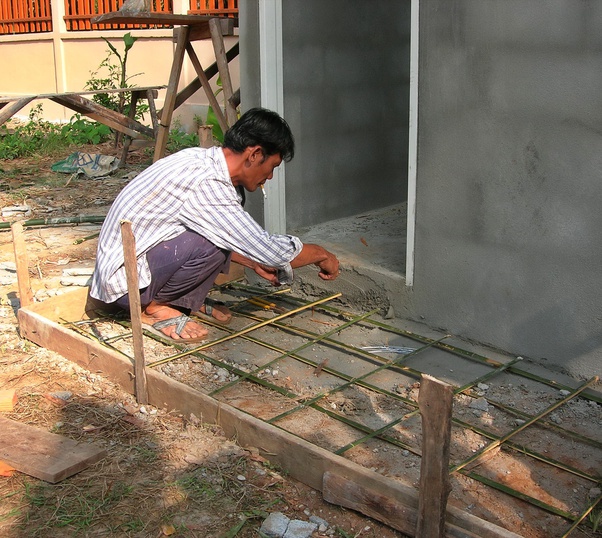
The energy necessary to produce 1m3per unit of stress projected in practice for materials commonly used in civil construction has been compared with that of bamboo. It has been found that it is necessary to spend 50 times more energy on steel than on bamboo.
Two tonnes of CO2 is produced during the manufacture of one tone of steel. In comparison, in addition to output, bamboo plants absorb CO2. According to ‘Hector Archila et. al. ’, the embodied energy of medium carbon steel is about 29–35 MJ/kg, while for bamboo this value is about 4–6 MJ/kg. The carbon footprint of steel is significantly greater than that of bamboo, with 2.2–2.8 kg CO2/kg (equivalent kg of CO2 per kg of material) for medium carbon steel and 0.25 kg CO2/kg for bamboo.
According to ‘Dr.J.Bhattacharjee and Aziz Arora’ (Published in: Suitability of Bamboo as a Reinforcement in Concrete), the tensile strength of bamboo is comparatively high and can reach up to 200-300 MPa. This makes it desirable to use bamboo as a steel substitute, particularly considering the relationship between tensile strength and specific weight of bamboo, which is six times higher than that of steel.
Bamboo is generally a hollow, anisotropic, natural material with high physical and mechanical property variability around the section and along the head. With average values ranging from 500 to 800 kg/m3, the bamboo density varies across the cross section (from the inner culm wall to the outer). Typically, bamboo displays a brittle nature in longitudinal tension-dominated failure modes. The variability of bamboo’s longitudinal mechanical properties is close to that of wood, with variance coefficients varying from 10 to 30 percent.
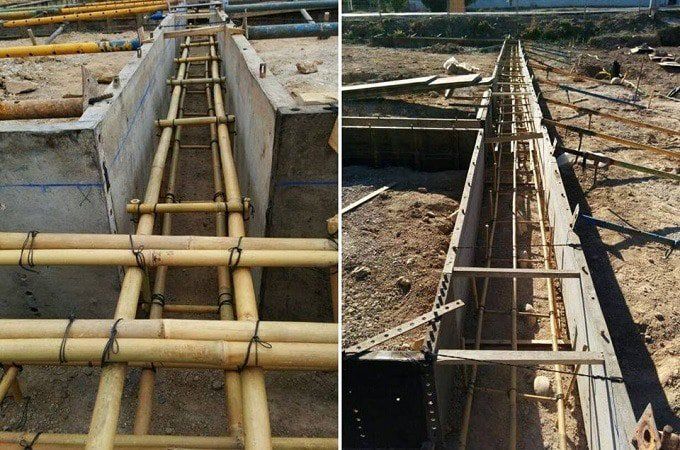
Due to the absence of radial fibres, bamboo is particularly weak in the direction perpendicular to the fibres, making it especially susceptible to longitudinal shear and transverse tension and compression failures. Steel, on the other hand, is a man-made, isotropic and ductile material having a density of 7800 kg/m3 and tensile yield strength of conventional reinforcing bars between 400 and 550 MPa.
In Southeast Asia, the use of bamboo to strengthen concrete buildings goes back a century. Early experimental tests of bamboo-reinforced concrete were done at MIT by Chow in Germany. In these experiments, either bamboo bars (small diameter wholesome) or splints were used (semi-round strips).
The following table shows the properties of bamboo in comparison to steel.

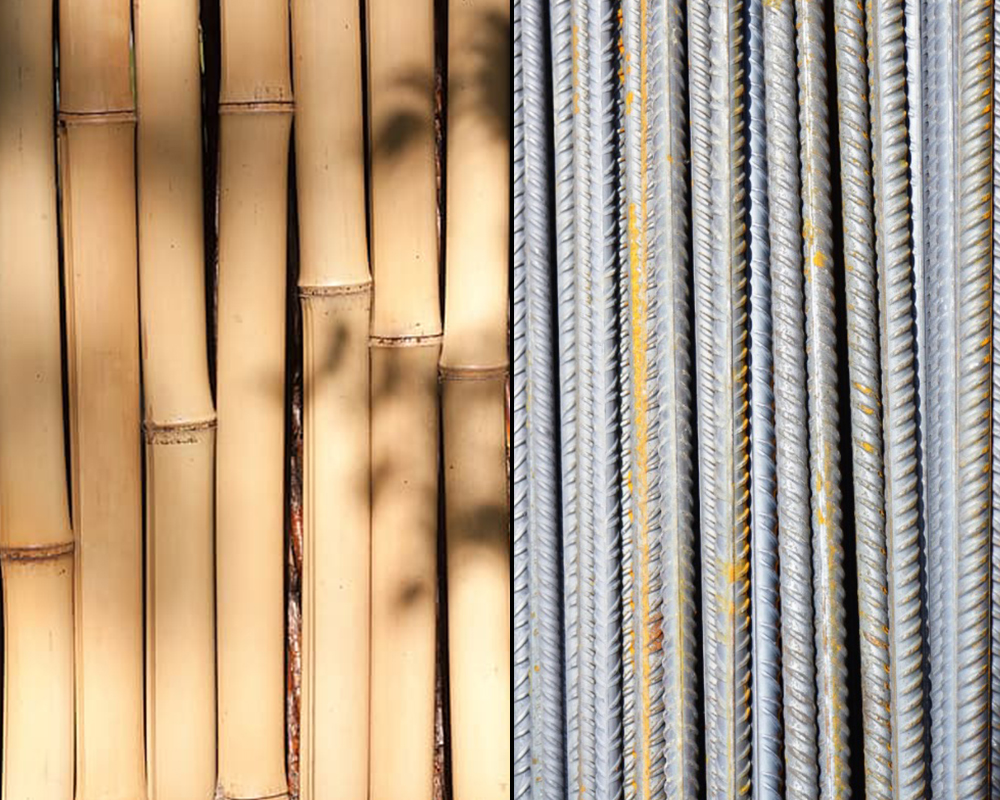
Advantages of Bamboo
01. The natural fibres of bamboo are extremely strong.
02. It has high tensile strength.
03. It is extremely flexible owing to its hollow nature.
04. Lightweight as compared to steel.
05. Cost-efficient and environment-friendly.
06. It has a great potential for shock absorption.
Disadvantages of Bamboo
01. In contrast with steel, it does not have a longer life.
02. As bamboo is less durable than steel, it cannot be used in the permanent structures.
03. Problems due to shrinking. In bamboo, the moisture content varies according to its height, location and seasoning time. It is one of the essential aspects in evaluating the life of bamboo. Use treated bamboo if you want your structure to last for more than 2 to 3 years.
04. More vulnerable to environmental degradation and attack by insects.
05. It cannot be used in cold weather.
06. Low elasticity modulus, and weak concrete mix adherence.
07. It can crack and deflect more than steel reinforcement due to low elasticity modulus.
In order to solve above limitation, the Chair of Architecture and construction at where Professor Dirk E. Hebel has created a new bamboo composite material that has a high tensile capacity and performs well in the long term in a concrete matrix. The material is solid and highly flexible and could serve as an efficient substitute for steel in reinforced concrete.
Instead of using bamboo as is typically the case in its natural tubular form, Hebel’s process first removes the natural fibres of the plant before mixing them with an organic resin. This composite material, called Bamboo TECH, is highly flexible and once pressed into shape, allows itself to tooling and handling in a manner similar to timber. When fashioned into thin rods, the composite material can be used as the supporting structural matrix for concrete in the same way as steel.
Case Study
The building was constructed at Bhopoli on the Western Express Highway in adiwasi area in Manor district. It is constructed during 2007-08. It was meant to be used as a hall and an office. The building consists of a traditional RCC column structure in the substructure with spread base & plinth beams and RCC column and floor beams in the superstructure.
The wall and slab components consist of bamboo reinforced panels cast on site that are externally attached. These panels consist of cement and polypropylene composite material moulded in the shape of corrugated sheets having dimension 2.7 m. x 0.9 m. With the help of fixtures, split bamboos were linked to the ridge portion of the corrugated board (nut-bolts). They were then placed across the span supporting on the beam.

Whole bamboos fitted with nut bolt to the transverse bamboo reinforcement are used for longitudinal reinforcement (Fig.2). A desired concrete mix thickness (as per structural design) was spread over it when all the panels were laid down. Bamboo is entirely built to function in tension zone and concrete in compression zone. The form-work required for the slab was also eliminated reducing the cost of formwork.
In the building, the walls used are of two types. The panels used for slabs were often used for walls, horizontally positioning them between the columns (Fig.3). Bamboo is positioned side by side with suitable joinery in some part of the wall, producing a complete bamboo façade on the external face (Fig.1). From the inside, all walls are plastered with cement mortar to get a smooth surface that is easy to paint.
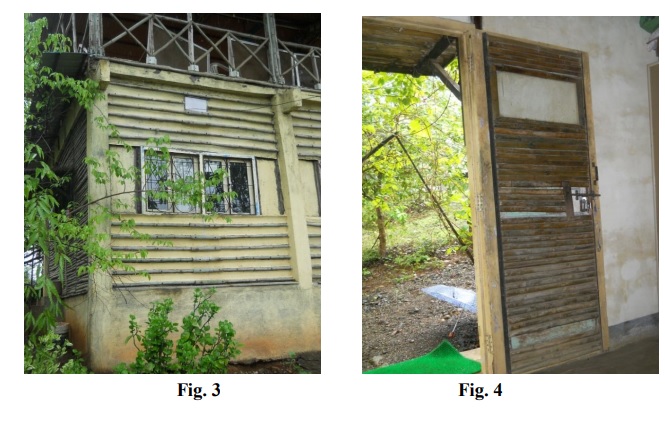
According to ‘Prof. Satish Pawar’ (Published in: Bamboo in Construction Technology), bamboo reinforced concrete can be effectively used for structural and non-structural applications in building applications for key structural components such as slabs, walls, columns and beams of a modest dwelling unit.
According to ‘Muthar’ (Published in: Precast Bridges of Bamboo Reinforced Concrete in Disadvantaged Village Areas in Indonesia), Precast bamboo reinforced concrete frame bridges has been built in Indonesia by Muthar and his team. The bridges were 320 cm in span, 224 cm in width and 115 cm in height. Four bridge beams were joined by two bridge frames. A 10-cm-thick concrete plate was made of the bridge plate. The hinge support is believed to be the bridge support of the reinforced concrete and the rubber bearing is assumed to be the roller support. The test for the bamboo reinforced concrete frame bridge was carried out directly with the load of a vehicle of the minibus type.
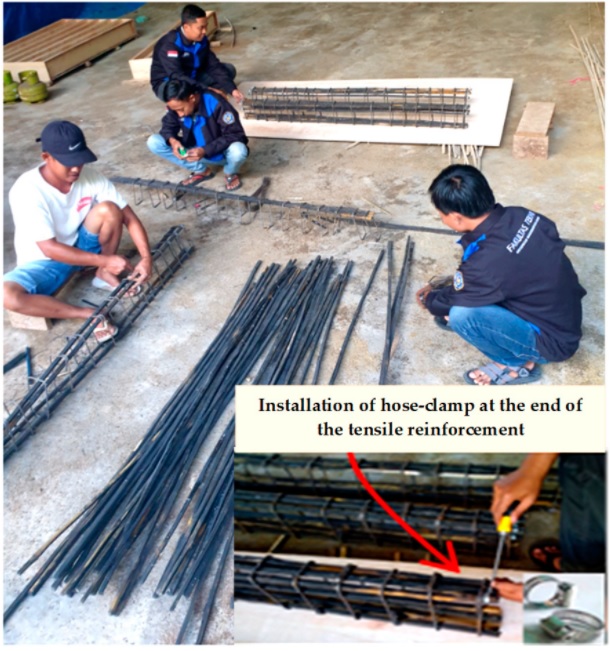
The test results showed that the precast bamboo reinforced concrete frame bridges have excellent integrity; that is, they can distribute loads that do not surpass their permissible limits of deflection and deformation. In the bridge frame, the maximum 0.25 mm displacement occurs, meeting the specifications based on the AASTHO and RSNI T-12-2004 criteria.
The bridge’s projected life span is 10 years. In this study, the determination of the age of the bridge is focused on opinions and research carried out by several researchers on the resistance of bamboo as a concrete reinforcement including Hidalgo (1992) in Sattar, Ghavami, Rong, and Lima Jr et al.. A progressive visual observation of the deflections and fractures will be carried out until the design life of the bridge is reached. The main objective of observing the longevity of bamboo as the concrete reinforcement of the bridge elements would be to perform observations every year. During the observation period, measured parameters are deflection and cracks that may occur due to bamboo reinforcement’s decreased durability.
According to ‘Mritunjay Kumar Singh’ et all, wherever required, steel and bamboo will be used together and no more than 25 percent of steel in a member to be replaced while no more than 40 percent to be replaced in the entire structure. Only structures where light loads are imparted can use bamboo as reinforcement in concrete. Bamboo can also be used to reinforce the partition walls, but 100 percent of steel can be replaced, unlike all the load bearing members, which will prove to be better than steel as in seismic proofing and keep the walls from losing integrity due to the nature of their stiffness.
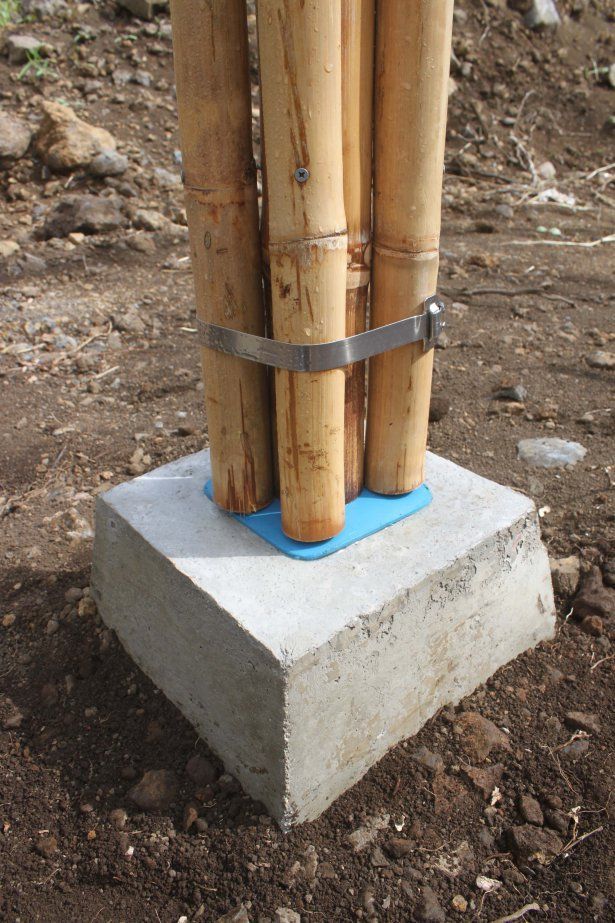
The G+1 structure that was used to validate the validity of the structure’s strength with the altered reinforcement properties can be used conventionally for real-life structure application, or the structure completely reinforced with steel can be reinforced with bamboo and the diameters of the bars in the zones in which it is used can be increased to maintain the strength factor.
Life of Bamboo
The service life of bamboo is controlled, as with all timbers, by its exposure position and durability, which together determine the rate of biological agent attack. Untreated bamboo has usually been found to have an average life of 1-3 years where it is directly exposed to the soil and atmosphere. The life expectancy of bamboo increases to 4-7 years when used under cover. Under very favourable circumstances, the service life of bamboo can be as high as 10-15 years, e.g. when used for rafters and internal framing.
Well, bamboo is not only used as reinforcement. There are several other applications where you can use bamboo. Check that, bamboo is used in fencing.
Speaking at the World Architecture Festival in Singapore, Hebel said the use of bamboo instead of steel was able to revolutionise the construction industry and finally offer an alternative to reinforced concrete.
According to ‘Hebel’, bamboo’s tensile strength aroused our curiosity as engineers and architects and inspired us to explore the possibility of extracting the fibre from the natural bamboo, transforming it into a manageable industrial product, and turning into a viable building material, a substitute to steel and timber. The composite material of bamboo can be made in any of the familiar ways and forms in which steel and timber are produced.
Like that the material can be used to build houses or any other buildings with wall structures. More interestingly, it can be used for specific applications which best take advantage of the tensile strength of the material, such as concrete reinforcement systems in concrete beams or ceilings and roof structures.
When used as a building material, Bamboo has some of the same sustainability advantages as timber, as a form of plant matter. It is a fully renewable resource that can be rapidly replenished by natural processes. It grows much faster than wood, is commonly available in large quantities, and is easy to acquire.
It is also recognised for its unrivalled carbon capture potential and could therefore play an important role in reducing global carbon emissions, another benefit for developing countries in terms of trade in terms of carbon emissions. Many developed nations should get involved in the content purely from an economic viewpoint. It could reinforce local supply chains, create more jobs and increase trade to these countries, and reduce their dependence on foreign markets.
To sum up, for countries lacking their own steel industries, the use of bamboo as reinforcement in concrete structures as an environmentally-friendly cure-all, provides that it is a hard, fast-growing plant that is especially well suited to those global climate zones hosting a large proportion of emerging economies.
Do not forget to read the steel reinforcement articles listed below.
Must Read:
Steel Reinforcement Types and their Properties!
Pros and Cons of Steel Reinforcement Bars
The Ultimate Guide to Steel Rebars Size and their Types































